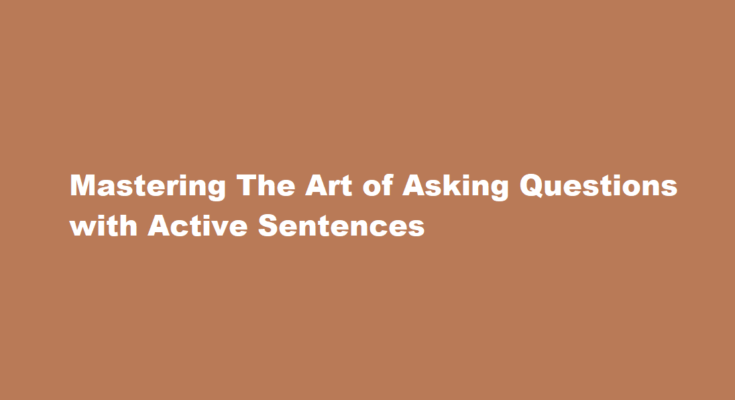Introduction
Asking effective questions is a fundamental skill that can greatly enhance communication and understanding. When faced with an answer, particularly one with an active sentence (AS), it is essential to know how to formulate the right question to extract further information. In this article, we will explore strategies to make questions that delve deeper into active sentence answers. By mastering this technique, you can unlock valuable insights, foster meaningful conversations, and broaden your knowledge base.
Understanding Active Sentences
Before we delve into crafting questions, it’s crucial to grasp the concept of active sentences. An active sentence typically follows a subject-verb-object structure, where the subject performs the action described by the verb on the object. For instance, “The cat chased the mouse” is an active sentence. Recognizing active sentences is essential because they provide valuable information about the actors and actions involved, enabling us to frame targeted questions to obtain specific details.
Identifying Key Elements
To construct effective questions, it’s important to identify the key elements within an active sentence. Begin by identifying the subject, verb, and object. These elements form the foundation of your questions. For example, in the sentence “John painted a beautiful landscape,” the subject is John, the verb is painted, and the object is a beautiful landscape. By recognizing these components, you can focus your questions on the subject’s motivations, the process of the action, or the attributes of the object, depending on the information you seek.
Expanding Questions Who, What, When, Where, Why, How
To extract comprehensive information, use the 5W1H technique – Who, What, When, Where, Why, and How. These question words help you expand your inquiries and explore various aspects of the active sentence answer. For instance
1. Who Who performed the action? Who else was involved?
2. What What action was performed? What were the outcomes?
3. When When did the action take place? When was it completed?
4. Where Where did the action occur? Where else might it have happened?
5. Why Why did the subject engage in the action? What were the motivations?
6. How How did the subject carry out the action? How did it impact others?
By utilizing these question words, you can formulate detailed inquiries that provide a deeper understanding of the active sentence answer.
Probing for Specifics
In addition to the 5W1H technique, probe for specific details to gain a more comprehensive view. Ask follow-up questions that address factors such as duration, frequency, scale, intensity, or other relevant aspects. For example
- How long did it take to complete the action?
- How often does the subject engage in this activity?
- How significant was the impact?
- Can you provide an example that illustrates the action?
By incorporating these probing questions, you encourage the respondent to provide specific information, thereby enriching your understanding of the active sentence answer.
Active Listening and Building on Responses
When receiving answers to your questions, practice active listening. Pay attention to the details provided and consider follow-up questions that build upon the response. Reflecting on the initial answer will help you identify areas that require further exploration. Engage in a constructive dialogue to encourage the sharing of additional insights, perspectives, or examples related to the active sentence.
FREQUENTLY ASKED QUESTIONS
How can we make questions with who as the subject?
If “what” or “who” is the subject in the sentence, we don’t need an auxiliary verb. The main verb goes right after the question word: What/Who + main verb + …?
How do you turn an answer into a question?
In order to convert a statement into a question you need to put the verb at the beginning of a sentence and add a question mark at the end. Sometimes the verb may have to be changed and an additional word added.
Conclusion
Mastering the art of asking questions when confronted with active sentence answers is a powerful skill that enhances communication and facilitates deeper understanding. By identifying key elements, using the 5W1H technique, probing for specifics, and practicing active listening, you can extract valuable information and engage in meaningful conversations. This approach will broaden your knowledge base, foster intellectual growth, and contribute to more effective communication in both personal and professional settings. Embrace the opportunity to explore the nuances of active sentences and discover the wealth of insights that lie within.
Read Also : A Beginner’s Guide Writing Programs in Pascal



